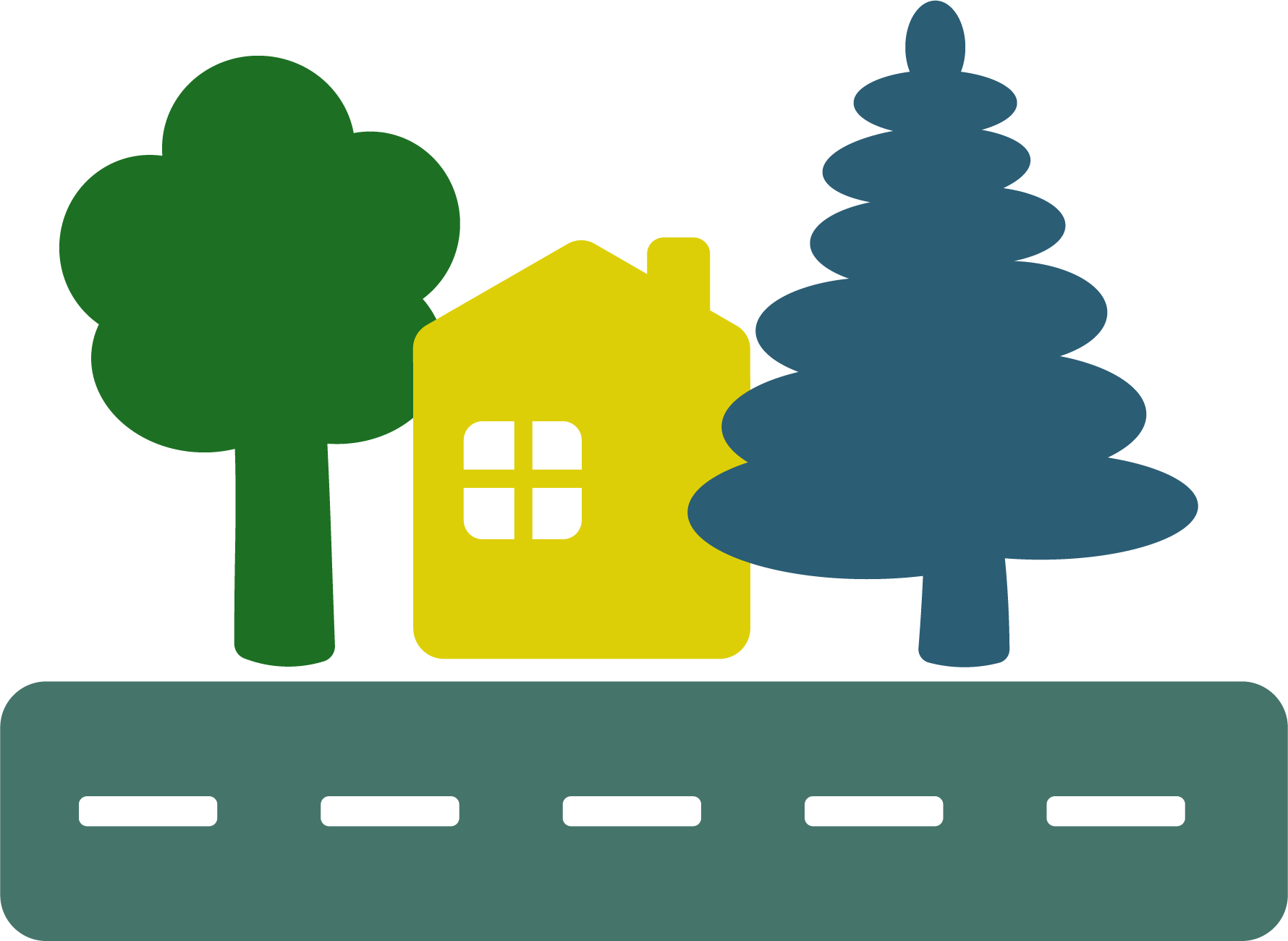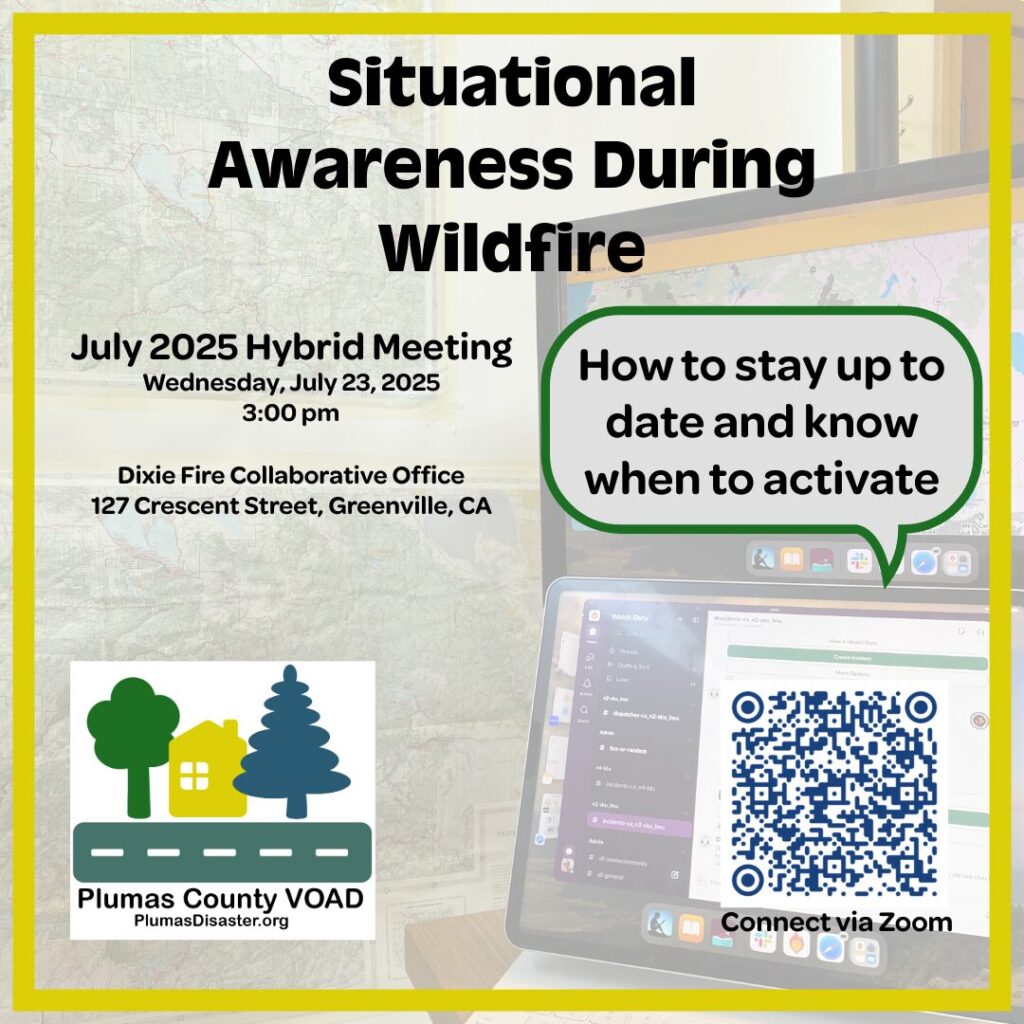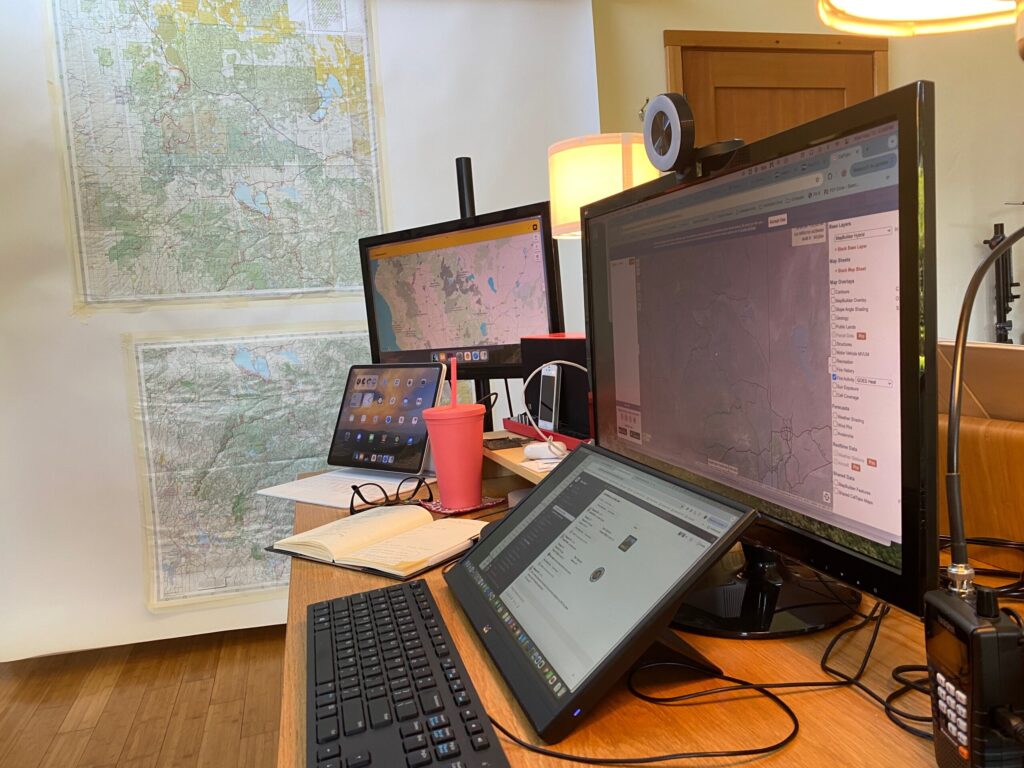This workshop was developed for a Plumas County VOAD meeting on 7/23/2025
Introduction
This workshop is geared toward citizen responders and secondary response organizations that are involved with their local VOAD – Voluntary Organizations Active in Disaster.
All the information presented reflects Plumas County, California, but you can do some research to update this information to reflect your local community.
Level 1: Introduction to Key Tools
With an internet connection or cell phone signal, you can access several key tools that will keep you up to date with wildfire events.
- Watch Duty reports on wildfires throughout the western United States, with automated data supported by experienced reporter analysts who verify information and provide updates on incidents. Watch Duty also shows weather, wind direction, power outages, live landscape cameras, and for a fee you can purchase additional features. Also available as an app for download to your mobile device.
- Fire agency incident tracking. In Plumas County, the large land manager is the US Forest Service, and we have both the Plumas National Forest and Lassen National Forest responding to wildfires. In addition, the Bureau of Land Management manages grasslands and other properties in Plumas County. All incidents that start on federal lands will be tracked on Inciweb.
- Federal Incidents – Inciweb
- CalFire IncidentsThere are also properties in Plumas County that are the responsibility of CalFire when it comes to wildfire. However, CalFire will typically coordinate with federal agencies for initial response, since there are few CalFire resources based in Plumas County.
- Local Responsibility Areas are those that are served by fire districts. These fire districts may provide an initial response, but for sizable wildland fires, the federal agencies will provide assistance. Use this map to check an address to see which fire district covers the property.
- This CalFire map shows the boundaries of the Federal, State, and Local responsibility areas.
- Wildland monitoring cameras. These cameras are controlled by public safety agencies and can pan and zoom to evaluate smoke and other conditions. Alert West provides access to a large number of cameras through their website. It takes a little exploration, but you can use the map on the website to zoom into an area and see all the camera views in one dashboard, with most recently moved cameras at the top. The map also shows you colored lines that indicate cameras that have recently moved.
Level 2: Monitoring Public Safety Agencies
Our public safety agencies all have web pages, but these pages are not updated in real time. Instead, look to Facebook for time critical information. Unfortunately, the Facebook algorithm will not show you posts in chronological order, so be sure you navigate to the agency’s page (using the links below), where you can see posts in order.
Facebook Links
- Plumas County Sheriff’s Office (PCSO) – Evacuations or shelter-in-place orders
- Plumas Office of Emergency Management – Emergency operations and coordination of county functions
- Plumas National Forest – fire suppression activity, prescribed burns, public land closure orders, and other safety information
- Lassen National Forest – North County fire suppression activity, prescribed burns, public land closure orders, and other safety information
- Tahoe National Forest – South County fire suppression activity, prescribed burns, public land closure orders, and other safety information
Dispatch logs
- Plumas National Forest
- Tahoe National Forest is supported by the Grass Valley Communications Center
- California Highway Patrol Dispatch Center – Susanville covers Plumas County. Choose the Susanville communications center from the pulldown menu at the top of the page.
- Federal agencies based in Susanville use the Susanville Interagency ECC, but their dispatch logs are not available on the internet.
Wireless Emergency Alerts
- PBS Warn (requires internet connection) – allows you to see what wireless alerts have been issued to cell phones within a prescribed geographical area, even if you are not within that area
Genasys Protect
- The Plumas County Sheriff’s Office uses this third party software to manage evacuations and shelter-in-place orders. You can sign up for alerts, see evacuation zones, and search by address.
Large Incident Planning Documents
- Available on the NIFC FTP Server
- Daily incident action plans
- Operations maps
- Public information maps
- Restoration maps
Power Outages and Restoration
There are several power utility companies that service Plumas County. While some have dedicated outage pages and opt-in text updates, others mainly use Facebook to update customers. The Watch Duty app has a layer that can be turned on to show current power outages for all the utilities.
- PG&E
- Outage Map
- Public Safety Power Shutoffs during severe wind events
- Liberty Utilities
- Outage Page with map (login required)
- Planned Outages
- Facebook page
- Plumas-Sierra Rural Electric Cooperative
Level 3: Listening to Public Safety Radio Traffic
Use Your Own Scanner
Radio scanners are one-way receivers that scan a wide range of frequencies. Affordable scanners can be purchased new, or look for a used handheld scanner like the Uniden BC125AT on EBay. It takes some patience and effort to set these up so that they are scanning just the channels you want to listen to, but they don’t require an internet connection and can be run from a battery if the power is out. You can also connect your scanner to an antenna to extend its reach, but be careful to avoid lightning and other risks that come with outdoor antenna installations.
- Radio Reference is a website tool for researching agencies and frequencies.
Listen Over the Internet
- Broadcastify is a webpage that allows people with scanners to stream their feeds over the internet.
- Look for general public safety channels by location. During disasters, organizations like Watch Duty may set up special channels covering only traffic from incident command agency.
- Plumas County Public Safety is streaming from Quincy
- Lassen County feeds may provide coverage that includes Lake Almanor area
- Archives are available on Broadcastify so that you can go back and find recordings from specific channels
- Consider streaming your own feed! Broadcastify provides a wealth of tools and knowledge to help you connect your local scanner to the internet
- Mobile apps are available that port over Broadcastify feeds to your mobile device. Scanner Radio is a popular option.
Public Safety Terminology
- Toneouts. When listening to public safety agencies, you’ll frequently hear tone-outs that activate pagers for different kinds of responses needed. https://wiki.radioreference.com/index.php/Tone_Signaling
- 10 codes and other shorthand terms used by CHP and police can be decoded using this handy guide
Fire Terms You Might Hear on the Scanner
- National Fire Danger Rating System (NIFC): https://gacc.nifc.gov/rmcc/predictive/fuels_fire-danger/drgloss.htm
- Glossary of Wildland Fire terms from the National Wildfire Coordinating Group (NWCG)
- Anatomy of a wildfire from the NWCG. Each side of the fire is described in terms of head, flank, and rear. The head is the fastest spreading part of a fire’s perimeter. The head is usually the side toward which the wind is blowing, and will also often be the upslope side of a fire. The head of the fire is of primary interest.
Level 4: Weather Fundamentals
The National Weather Service website is the best source for weather forecasts and event information and warnings. Unlike the app that comes with your mobile phone, which is usually based on a single weather model, the NWS forecasts use multiple weather models (called ensembles) and a huge amount of human intelligence to create forecasts, in particular the warnings that are issued for storms and fire weather. The NWS is not allowed to have its own weather app, so you need to access it through an internet browser.
- Become a weather spotter! SkyWARN https://www.weather.gov/skywarn/
- There are tons of free online weather training available at MetEd. https://www.meted.ucar.edu/education_training
- The best weather radar app is RadarScope, which costs $10 to purchase, or you can subscribe to the premium service for an additional $14/month.
- The best lightning app is My Lightning Tracker, available as a free app with paid ad-free option.
NOAA Weather Radio and Alerts
- Buy a battery operated radio that broadcasts the NOAA weather station. If you get a radio that has SAME capabilities, you’ll be able to set it up to decode certain kinds of alert tones, similar to the toneouts you hear on a scanner. https://www.weather.gov/mob/nwrhelp
- For Plumas County, the following frequencies may be caught on your weather radio, sourced from the NWS for California and Nevada.
| Ch# | Frequency | Plumas County Warning Area Transmitters |
|---|---|---|
| 1 | 162.400 MHz | |
| 2 | 162.425 MHz | |
| 3 | 162.450 MHz | Fernley, NV |
| 4 | 162.475 MHz | |
| 5 | 162.500 MHz | Susanville, CA |
| 6 | 162.525 MHz | |
| 7 | 162.550 MHz | Reno, NV, Redding, CA and Sacramento, CA |
Level 5: Community Updates and Information During Wildfire
211
The 211 information service is new to Plumas County and is operated by the Northern California United Way. 211 connects you to knowledgeable and confidential help.
- Dial 211 on your phone within Plumas County, or from outside Plumas County call 844-652-0822
- You can also visit their webpage
- During disasters, United Way will set up a special website to provide information to affected people
Education
These websites will provide updates about school closures and evacuations.
- County Office of Education: Plumas County Office of Education and Plumas Unified School District
- Sierra-Plumas Joint Unified School District and Sierra County Office of Education
- Plumas Charter Schools
- Feather River College
Roads and Transit
Plumas County Road Conditions
State Route Road Conditions from CalTrans – Quickmap is also available as an app for mobile devices
California Highway Patrol Dispatch Center – Susanville covers Plumas County. Choose the Susanville communications center from the pulldown menu at the top of the page.
Plumas County Transit provides public van transportation within Plumas County and is operated by Plumas Rural Services. Plumas County Transit also provides para-transit services.
Plumas County Senior Nutrition and Transportation provides rides to and from doctors offices, including within and outside Plumas County. They also provide rides for other purposes within Plumas County.
Plumas County VOAD
- Voluntary Organizations Active in Disaster are collectives of non-profits and volunteers who respond to support communities during disaster
- Plumas County VOAD activates when the county government activates its Emergency Operations Center
FEMA – Federal Emergency Management Agency
FEMA will activate after a major natural disaster has been declared a federal disaster. But you can monitor FEMA activities in two ways:
- FEMA Daily Operations Briefing: https://disastercenter.com/FEMA%20Daily%20Operation%20Brief.pdf
- Or sign up for daily email updates here: https://service.govdelivery.com/accounts/USDHSFEMA/subscriber/topics
Incident Profiles and Reporting
When you are collecting information to share with your friends, family, and networks, please use verified information that comes from official sources.



